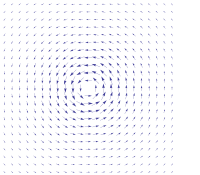De Rham cohomology

De Rham cohomology is a big word, so let's break it down into smaller pieces.
First, let's start with what "cohomology" means. Do you know what "homology" is? No worries if you don't. Homology is a way of measuring the holes or twists in shapes. Think about a donut and a ball. The donut has a hole in the middle, while the ball does not. Homology helps us understand this difference.
Now, "cohomology" is similar to homology but looks at slightly different things. Instead of looking at the holes or twists in a shape, cohomology looks at the ways paths or lines can move on the shape.
Next, "de Rham" is a fancy name, but it actually comes from a person named Georges de Rham who helped develop this mathematical idea. So when we say "de Rham cohomology," we're talking about this specific way of looking at paths or lines on shapes.
Now, let's think about how this all connects to the real world. Imagine you are drawing a picture of a windy road. You use a pencil to draw the lines of the road, right? Well, those lines are like the paths we were talking about.
In de Rham cohomology, we're interested in how these paths can move around on the shape. For example, can we take a windy road and turn it into a straight path? Or can we take a straight path and curl it up like a snake? These kinds of questions help us understand the shape and its different paths.
But why is this important? Well, mathematicians and scientists use de Rham cohomology to understand many different things. For example, in physics, it helps us understand electromagnetism and how electricity and magnetism interact with each other. In geometry, it helps us understand the shapes and spaces that we can't see in our everyday world.
So, to sum it all up, de Rham cohomology is a way for mathematicians and scientists to better understand the paths or lines on shapes and how they can move around. It helps us study the world in new and exciting ways!
First, let's start with what "cohomology" means. Do you know what "homology" is? No worries if you don't. Homology is a way of measuring the holes or twists in shapes. Think about a donut and a ball. The donut has a hole in the middle, while the ball does not. Homology helps us understand this difference.
Now, "cohomology" is similar to homology but looks at slightly different things. Instead of looking at the holes or twists in a shape, cohomology looks at the ways paths or lines can move on the shape.
Next, "de Rham" is a fancy name, but it actually comes from a person named Georges de Rham who helped develop this mathematical idea. So when we say "de Rham cohomology," we're talking about this specific way of looking at paths or lines on shapes.
Now, let's think about how this all connects to the real world. Imagine you are drawing a picture of a windy road. You use a pencil to draw the lines of the road, right? Well, those lines are like the paths we were talking about.
In de Rham cohomology, we're interested in how these paths can move around on the shape. For example, can we take a windy road and turn it into a straight path? Or can we take a straight path and curl it up like a snake? These kinds of questions help us understand the shape and its different paths.
But why is this important? Well, mathematicians and scientists use de Rham cohomology to understand many different things. For example, in physics, it helps us understand electromagnetism and how electricity and magnetism interact with each other. In geometry, it helps us understand the shapes and spaces that we can't see in our everyday world.
So, to sum it all up, de Rham cohomology is a way for mathematicians and scientists to better understand the paths or lines on shapes and how they can move around. It helps us study the world in new and exciting ways!
Related topics others have asked about:
